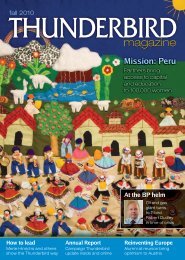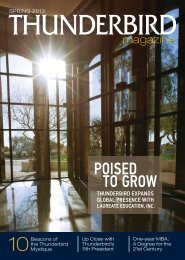Spring 11 MASTER.indd - Thunderbird Magazine
Spring 11 MASTER.indd - Thunderbird Magazine
Spring 11 MASTER.indd - Thunderbird Magazine
Create successful ePaper yourself
Turn your PDF publications into a flip-book with our unique Google optimized e-Paper software.
iofuel revolution<br />
same as <strong>Thunderbird</strong> students arrive with Zerio<br />
for a site visit on Jan. 13, 20<strong>11</strong>. But chemical engineer<br />
Jaime Finguerut sees important differences.<br />
His for-profit center about two hours north of<br />
São Paulo develops sugarcane varieties for domestic<br />
growers, and each experimental field represents<br />
different innovation.<br />
“The domestication process is not new,”<br />
Finguerut tells the students gathered in the center’s<br />
main auditorium. “After more than one<br />
thousand years of selection and crossing, we have<br />
a complex hybrid grass somewhat like Frankenstein’s<br />
creation.”<br />
Even before the Portuguese arrived in the<br />
1500s, people realized sugarcane was tasty and<br />
began crossing the sweetest varieties with other<br />
grasses suitable for different regions.<br />
Finguerut says the process continues today in<br />
a race to maximize production and reduce costs.<br />
“We have to produce more sugarcane in the same<br />
area,” he says. “The only way to produce more or to<br />
decrease the cost is to produce with new varieties.”<br />
He says different varieties thrive in different<br />
regions, and finding the right type for each location<br />
allows growers to save on fertilizer, water and<br />
other costs. Different varieties also mature at different<br />
times, which allows growers to extend the<br />
harvest season.<br />
“Sugarcane has to be processed fresh and very<br />
fast,” Finguerut says. “You cannot store sugarcane<br />
because it contains very edible sugar that<br />
everyone loves — including bacteria, fungus and<br />
insects.”<br />
He says Brazil provides an ideal climate for the<br />
crop, which requires months of heavy rain followed<br />
by a dry harvest season. But even within<br />
Brazil, conditions vary.<br />
“Even in a 20-kilometer radius around the processing<br />
site, we have different types of soil, different<br />
types of water availability and different types<br />
of pests,” he says. “Sugarcane has to be adapted<br />
to these stresses.”<br />
MAKING TRADEOFFS<br />
Not everyone in Brazil agrees with the urgency<br />
of the need to boost sugarcane production as rapidly<br />
as possible. Critics point to several tradeoffs<br />
and unintended consequences that come with<br />
the proliferation of ethanol mills.<br />
Problems include deforestation, environmental<br />
contamination from pesticides and fertilizers,<br />
the spread of airborne pollutants from crop burning,<br />
and pressure on small farms as industrial<br />
operations move in with backing from foreign<br />
investors.<br />
Developing countries such as Brazil also must<br />
Brazil Winterim students<br />
with <strong>Thunderbird</strong><br />
Professor John Zerio,<br />
Ph.D., right, visit a<br />
sugarcane plantation Jan.<br />
<strong>11</strong>, 20<strong>11</strong>, near Ribeirão<br />
Preto in São Paulo state.<br />
thunderbird magazine 39

















